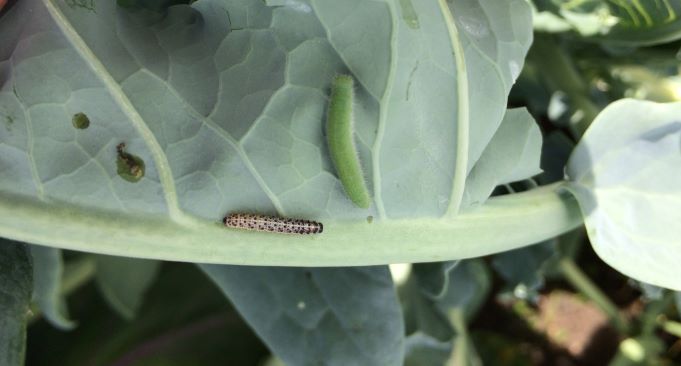Please click here to access the main AHDB website and other sectors.
- Home
- Knowledge library
- Pest insects in brassica crops: caterpillars
Pest insects in brassica crops: caterpillars
Caterpillars can cause damage to brassicas by feeding and can also be contaminants. It’s important to monitor your crops for signs and time your treatments carefully according to pest life cycles.
The caterpillars of several species of moth and butterfly can be pests of brassica crops (see table).
Pest caterpillars of horticultural Brassicas:
| Species | Activity periods | Importance | Monitoring methods |
| Small white butterfly (Pieris rapae) |
May/June and late summer – more abundant in late summer |
Can be damaging and hard to see on plants |
Yellow water trap or sticky trap |
| Large white butterfly (Pieris brassicae) |
May/June and late summer – more abundant in late summer |
Can be damaging but usually infests a small number of plants in large numbers and damage is generally obvious |
Yellow water trap or sticky trap |
| Cabbage moth (Mamestra brassicae) |
May/June and late summer – more abundant in late summer |
Localised pest – can be hard to see on plants when young |
Pheromone trap |
| Garden pebble moth (Evergestis forficalis) |
May/June and late summer – more abundant in late summer |
Localised pest – hard to see on plants |
Pheromone trap |
| Diamondback moth (Plutella xylostella) |
Mainly migrant species and can arrive at any time – usually from June onwards |
Can be very damaging and hard to see on plants when small |
Pheromone trap |
| Silver Y moth (Autographa gamma) |
Migrant and can arrive at any time from early spring |
Rarely causes significant damage on Brassicas |
Pheromone trap |
| Turnip moth (cutworm) (Agrotis segetum) |
Late May–early July, sometimes a second generation in later summer |
Rarely causes significant damage on Brassicas |
Pheromone trap Forecast available |

Life cycles
Apart from the diamondback moth and silver Y moth, which are migrants, all species overwinter throughout the UK, in the pupal stage or as larvae (turnip moth). There is increasing evidence that small populations of diamondback moth may be able to overwinter in warm locations (e.g. South West England), but this species does not have a specific overwintering stage. All but the migrant species have two generations per year (see table). The diamondback moth may complete two or more generations, depending on when it arrives in the UK. The silver Y moth will complete at least one generation.
Damage
All caterpillar species cause direct feeding damage and can be contaminants in harvested produce (see table above for details).
Monitoring and forecasting
Regular crop walking is important for identifying pest problems in your crops. Treatment timing is particularly critical for the diamondback moth, whose life cycle can be very rapid.
Pest traps
Like the cabbage root fly, adult small white and large white butterflies can be monitored using yellow water traps or sticky traps. Adult males of all moth species can be captured in specific pheromone traps. Captures of male moths in the traps indicate when female moths are likely to be laying eggs in the crop.
Forecasting
For the turnip moth (cutworm), data from trap captures in 2005–2007 at Wellesbourne were used to estimate a D° sum for the start of flight activity. This was 340D° above a base of 7°C from 1 January. The cutworm model uses weather data to predict the rate of development of turnip moth eggs and caterpillars. It also predicts the level of rain-induced mortality among the early instar caterpillars. The cutworm model has been programmed into the MORPH decision-support software and can be used to produce forecasts with the weather data used to produce the cabbage root fly and pollen beetle forecasts.
Non-chemical control methods
There are no established non-chemical methods for reducing the overall population of these pests. Fine mesh netting used to exclude cabbage root fly will also exclude adult butterflies and moths. However, it’s likely that some species, particularly the diamondback moth, will lay eggs on the netting where it touches the crop, allowing the larvae to access the foliage.
Useful links
Read about pest insects in brassica crops: fly pests
Read about pest insects in brassica crops: beetle
Read about pest insects in brassica crops: aphids
Read about pest insects in brassica crops: cabbage whitefly
Read about whole crop IPM strategy for pest insects in brassica crops
Topics:
Sectors:
Tags:


